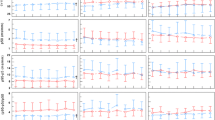Abstract
Purpose: To study refractoriness and conduction interaction during modulation of non-ischemic ventricular fibrillation (VF) by flecainide.
Methods: Isolated feline and rabbit hearts were used. (a) In the feline hearts (n = 8), electrophysiological parameters were measured before and after flecainide administration (0.6, 1.2 × 10−6 M). During pacing the parameters were: epicardial conduction time, refractoriness and 1:1 pacing/response capture. During 8 min of electrically-induced tachyarrhythmias they included heart rate and normalized entropy reflecting the degree of organization. (b) In rabbit hearts (n = 4), three-dimensional mapping was performed before and after flecainide administration (2 × 10−6 M). To follow changes in organization, local RR-intervals and differences in activation time between adjacent epicardial electrodes were measured immediately and 80 sec after VF induction.
Results: In feline hearts with flecainide, fibrillation was more difficult to induce, more frequently terminated spontaneously and was slower and more organized; conduction time was markedly lengthened, and refractoriness less than 1:1 capture, was moderately prolonged. An inverse correlation was observed between arrhythmia properties, rate and organization, and changes in refractoriness and conduction time. In rabbit, the number of wave fronts was reduced, RR-intervals were prolonged but at the same time activation time differences between adjacent electrodes were smaller following flecainide administration.
Conclusions: It is suggested that flecainide modulation of VF properties is associated with conduction suppression and refractoriness prolongation, which act in a synergistic, additive way.
Similar content being viewed by others
References
Lee J, Kamjoo K, Hough D, et al. Reentrant wave fronts in Wiggers' stage II ventricular fibrillation. Circ Res 1996;78:660-675.
Kwan YY, Fan W, Kamjoo K, et al. The effects of procainamide on the characteristics of functional reentry in canine ventricular fibrillation. Circulation 1998;97:1828-1836.
Pertsov AM, Davidenko JM, Salomonsz R, Baxter WT, Jalife J. Spiral waves of excitation underlies reentrant activity in isolated cardiac muscle. Circ Res 1993;72:631-650.
Moe GK, Rheinboldt WL, Abildskov JA. A computer model of atrial fibrillation. Am Heart J 1964;64:200-220.
Choi BR, Liu T, Salama G. The distribution of refractory periods influences the dynamics of ventricular fibrillation. Circ Res 2001;88:e49-e58.
Karma A. Spiral breakup in model equations of action potential propagation in cardiac tissue. Phys Rev Lett 1993;71:1103-1106.
Kim YH, Yashima M, Wu TJ, Doshi R, Chen PS, Karagueuzian HS. Mechanisms of procaine-induced prevention of spontaneous wave break during ventricular fibrillation. Insight into the maintenance of fibrillation wave fronts. Circulation 1999;100:666-674.
Mandapati R, Asano Y, Baxter WT, Gray R, Davidenko J, Jalife J. Quantification of effects of global ischemia on dynamics of ventricular fibrillation in isolated rabbit heart. Circulation 1998;98:1688-1696.
Amitzur G, Schoels W, Visokovsky A, et al. Role of sodium channels in ventricular fibrillation: A study in non-ischemic isolated hearts. J Cadiovasc Pharmacol 2000;36:785-793.
Zipes DP. Management of cardiac arrhythmias: Pharmacological, electrical and surgical technique. In: Braunwald E, ed. Heart Disease, 5th ed. Philadelphia: WB Saunders, 1997:593-639.
Martin DK, Nakaya Y, Wyse KR, Campbell TJ. Effects of disopyramide and flecainide on the kinetics of inward rectification potassium channels in rabbit heart muscle. Br J Pharmacol 1994;11:873-879.
Nemeth M, Virag L, Varro A, Papp JG. Comparison of the effects of restracorin and flecainide on various cardiac transmembrane potassium currents. Acta Physiol Hung 1996;84:317-328.
Eckardt L, HaverkampW, Gottker U, et al. Divergent effect of acute ventricular dilatation on the electrophysiologic characteristics of d,l-sotalol and flecainide in the isolated rabbit heart. J Cardiovasc Electrophysiol 1998;9:366-383.
Balderstob SM, Johnson KE, Reiter MJ. Electrophysiologic evaluation of cardiovascular agents in the isolated intact rabbit heart. J Pharmacol Meth 1991;25:205-213.
Kinnaird A, Lederman CL, Man RYK. Electrophysiological actions of flecainide in normal and infracted canine purkinje fibers. Eur J Pharmacol 1985;112:57-64.
Ikeda N, Singh BN, Davis LD, Hauswirth. Effects of flecainide on the electrophysiologic properties of isolated canine and rabbit myocardial fibers. J Am Coll Cardiol 1985;5:303-310.
Lang J, Timour Q, Aupett JF, Lancon JP, Lakhal M, Faucon G. Frequency and time-dependent depression of ventricular distal conduction by two novel antiarrhythmic drugs, cibenzoline and flecainide. Arch Int Pharmacodyn 1988;293:97-108.
Brugada J, Boersma L, Kirchof C, Allessie M. Proarrhythmic effects of flecainide. Experimental evidence for increased susceptibility to reentrant arrhythmias. Circulation 1991;84:1808-1818.
Follmer CH, Colatsky TJ. Block of delayed rectifier potassium current, Ik, by flecainide & E-4031 in cat ventricular myocytes. Circulation 1990;82:289-293.
Amitzur G, Pogatz V, Nobikov I, Kaplinsky E, Eldar M. Modulation of ventricular fibrillation in the isolated heart; the role of slow calcium channel activity under continuous perfusion. J Cardiovasc Pharmacol 2000;35:16-28.
Merillat J, Lakatta EG, Hano O, Guarnieri T. Role of calcium and the calcium channel in the initiation and maintenance of ventricular fibrillation. Circ Res 1990;67:1115-1123.
Oppenheim AV, Schafer RW. Digital Signal Processing. Prentice Hall Co., Inc., 1975.
Kullback S. Information Theory and Statistics. New York: Dover Co., Inc., 1968.
Freigang KD, Bauer A, Becker R, et al. Differential effects of d-sotalol on normal and infarcted myocardium: An experimental study using epicardial mapping. Cardiovasc Res 1997;35:52-59.
Krishan SC, Antzelevich C. Sodium channel block produces opposite electrophysiological effects in canine ventricular epicardium and endocardium. Circ Res 1991;69:277-291.
Steinberg MI, Molloy BB. Clofilium-a new anti-fibrillatory agent that selectively increases cellular refractoriness. Life Sci 1979;25:1397-1406.
Allessie MA, Wijffels MC, Dorland R. Mechanisms of pharmacologic cardioversion of atrial fibrillation by class I drugs. J Cardiovasc Electrophysiol 1998;9(suppl):S69-S77.
Chorro FJ, Canoves J, Guerrero J, et al. Alteration of ventricular fibrillation by flecainide, verapamil, and sotalol. An experimental study. Circulation 2000;101:1606-1615.
Mueller M, Amitzur G, Bauer A, Kraft P, Schoels W. Electrical remodeling during ventricular fibrillation: Effects of class I antiarrhythmic drugs (abstr). Pace 1999;22:819.
The Cardiac Arrhythmias SuppressionTrials (CAST) Investigators: Effect of encainide and flecainide on mortality in randomized trial of arrhythmia suppression after mycardial infarction. N Engl J Med 1989;321:406-412.
Author information
Authors and Affiliations
Rights and permissions
About this article
Cite this article
Amitzur, G., Shenkar, N., Mueller, M. et al. Refractoriness and Conduction Interaction During Modulation of Non-Ischemic Ventricular Fibrillation by Flecainide. Cardiovasc Drugs Ther 17, 237–247 (2003). https://doi.org/10.1023/A:1026124224369
Issue Date:
DOI: https://doi.org/10.1023/A:1026124224369




